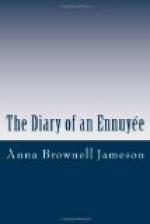Oct. 21.—Verona is a clean and quiet place, containing some fine edifices by Palladio and his pupils. The principal object of interest is the ancient amphitheatre; the most perfect I believe in Italy. The inner circle, with all its ranges of seats, is entire. We ascended to the top, and looked down into the Piazza d’arme, where several battalions of Austrian soldiers were exercising; their arms glittering splendidly in the morning sun. As I have now been long enough in Italy to sympathize in the national hatred of the Austrians, I turned from the sight, resolved not to be pleased. The arena of the amphitheatre is smaller, and less oval in form than I had expected: and in the centre, there is a little paltry gaudy wooden theatre for puppets and tumblers,—forming a grotesque contrast to the massive and majestic architecture around it: but even tumblers and puppets, as Rospo observed, are better than wild beasts and ferocious gladiators.
There are also at Verona a triumphal arch to the Emperor Gallienus; the architecture and inscription almost as perfect as if erected yesterday;—and a most singular bridge of three irregular arches, built, I believe, by the Scaligieri family, who were once princes of Verona.
It is well known that the story of Romeo and Juliet is here regarded as a traditionary and indisputable fact, and the tomb of Juliet is shown in a garden near the town. So much has been written and said on this subject, I can add only one observation. To the reality of the story it has been objected that the oldest narrator, Masuccio, relates it as having happened at Sienna: but might he not have heard the tradition at Verona, and transferred the scene




